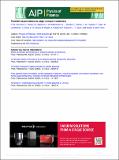Poloidal asymmetries in edge transport barriers
Author(s)
Chang, C. S.; Hager, R.; Churchill, Randy Michael; Theiler, Christian; Lipschultz, Bruce; Hutchinson, Ian Horner; Reinke, Matthew Logan; Whyte, Dennis G; Hughes Jr, Jerry; Catto, Peter J; Landreman, Matthew Joseph; Ernst, Darin R; Hubbard, Amanda E; Ennever, Paul Chappell; Walk Jr, John R; ... Show more Show less
DownloadHutch ChurchillPoP2015.pdf (2.263Mb)
OPEN_ACCESS_POLICY
Open Access Policy
Creative Commons Attribution-Noncommercial-Share Alike
Terms of use
Metadata
Show full item recordAbstract
Measurements of impurities in Alcator C-Mod indicate that in the pedestal region, significant poloidal asymmetries can exist in the impurity density, ion temperature, and main ion density. In light of the observation that ion temperature and electrostatic potential are not constant on a flux surface [Theiler et al., Nucl. Fusion 54, 083017 (2014)], a technique based on total pressure conservation to align profiles measured at separate poloidal locations is presented and applied. Gyrokinetic neoclassical simulations with XGCa support the observed large poloidal variations in ion temperature and density, and that the total pressure is approximately constant on a flux surface. With the updated alignment technique, the observed in-out asymmetry in impurity density is reduced from previous publishing [Churchill et al., Nucl. Fusion 53, 122002 (2013)], but remains substantial (nz,H/nz,L∼6). Candidate asymmetry drivers are explored, showing that neither non-uniform impurity sources nor localized fluctuation-driven transport are able to explain satisfactorily the impurity density asymmetry. Since impurity density asymmetries are only present in plasmas with strong electron density gradients, and radial transport timescales become comparable to parallel transport timescales in the pedestal region, it is suggested that global transport effects relating to the strong electron density gradients in the pedestal are the main driver for the pedestal in-out impurity density asymmetry.
Date issued
2015-04Department
Massachusetts Institute of Technology. Plasma Science and Fusion CenterJournal
Physics of Plasmas
Publisher
American Institute of Physics (AIP)
Citation
Churchill, R. M.; Theiler, C.; Lipschultz, B.; Hutchinson, I. H.; Reinke, M. L.; Whyte, D.; Hughes, J. W. et al. “Poloidal Asymmetries in Edge Transport Barriersa).” Physics of Plasmas 22, no. 5 (May 2015): 056104. © 2015 AIP Publishing LLC.
Version: Author's final manuscript
ISSN
1070-664X
1089-7674